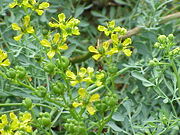Common Rue
| Common Rue | ||||||||||||||||
|---|---|---|---|---|---|---|---|---|---|---|---|---|---|---|---|---|
 Common Rue in flower
|
||||||||||||||||
| Scientific classification | ||||||||||||||||
|
||||||||||||||||
| Binomial name | ||||||||||||||||
| Ruta graveolens L. |
The Common Rue (Ruta graveolens), also known as Herb-of-grace, is a species of rue grown as a herb. It is native to southern Europe. It is sometimes grown as an ornamental plant in gardens, especially because of its bluish leaves, and also sometimes for its tolerance of hot and dry soil conditions. It also is grown as both a medicinal herb and as a condiment.
Contents |
Usage
Medicinal use
In European folk medicine, rue is said to relieve gas pains and colic, improve appetite and digestion, and promote the onset of menstruation and uteral contractions. For this reason the refined oil of rue has been cited by the Roman historian Pliny the Elder and the gynecologist Soranus, as a potent abortifacient (inducing abortion). Rue contains pilocarpine which is used in horses to induce abortion, and is a traditional abortifacient among Hispanic people in New Mexico.[1]
Rue can also be made into an ointment for external use against gout, arthritis, rheumatism and neuralgia.
Culinary use
Rue does have a culinary use if used sparingly, however it is incredibly bitter and severe gastric discomfort may be experienced by some individuals. Although used more extensively in former times it is not a herb that typically suits modern tastes, and thus its use declined considerably over the course of the 20th century to the extent that it is today largely unknown to the general public and most chefs, and unavailable in grocery stores.[2] Rue leaves and berries are an important part of the cuisine of Ethiopia and rue is also used as a traditional flavouring in Greece and other Mediterranean countries. In Istria, there is a grappa/rakija recipe that calls for a sprig of rue. The plant produces seeds that can be used for porridge. The bitter leaf can be added to eggs, cheese, fish, or mixed with damson plums and wine to produce a meat sauce.
Rue is also grown as an ornamental plant, both as a low hedge and so the leaves can be used in nosegays. Most cats dislike the smell of it and therefore it can be used as a deterrent to them (see also Plectranthus caninus).
References
- ↑ Riddle, John M. 1992. Contraception and abortion from the ancient world to the Renaissance. Harvard University Press. p. 28-29.
- ↑ "Rue (Ruta graveolens L.)".
External links
- Rue (Ruta graveolens L.) page from Gernot Katzer's Spice Pages
|
||||||||||||||||||||||||||||||||||||||||||